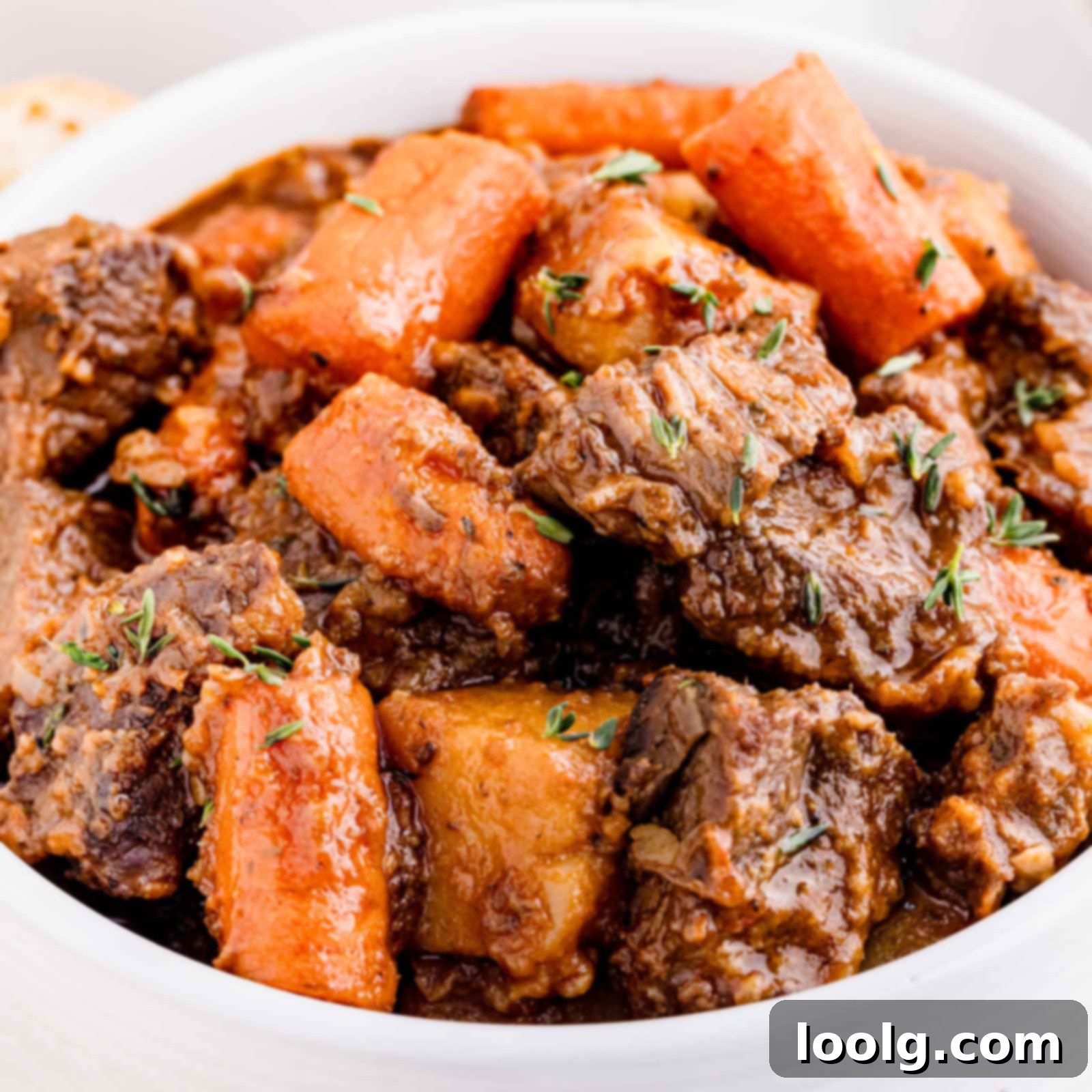Hearty & Comforting Slow-Cooked Venison Stew: A Rich Deer Meat Recipe
This venison stew recipe is the epitome of comfort food, masterfully blending robust flavors with fork-tender deer meat in a dish that simmers to perfection. Designed to highlight the unique richness and lean texture of venison, this slow-cooked stew offers a deeply savory experience that sets it apart from traditional beef stew. Its earthy notes pair exquisitely with an abundance of wholesome vegetables and aromatic herbs, creating a meal that feels both rustic and incredibly refined.
Imagine a chilly evening, and a simmering pot on the stove filling your home with an irresistible aroma. That’s the magic of this venison stew. Slow-cooking isn’t just a method here; it’s a philosophy, allowing each ingredient to contribute its best to a symphony of flavors. Whether you’re gathering your family for a cozy dinner or aiming to impress guests with straightforward yet elegant venison recipes, this dish promises to be a memorable crowd-pleaser.
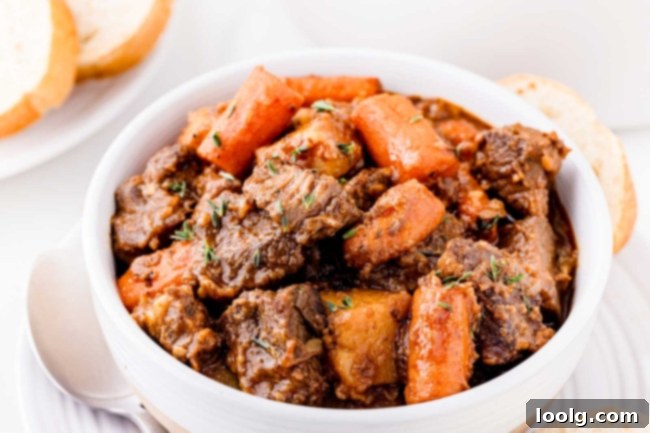
Venison, known as deer meat, is celebrated for being a leaner and more intensely flavored alternative to beef, providing a distinct depth of taste that’s truly unmatched. This particular stew recipe embraces venison’s natural qualities, transforming it into a nourishing and profoundly satisfying meal with surprising ease. It’s often hailed as one of the best easy venison stew recipes for any home cook looking to elevate their culinary repertoire without extensive effort.
Each generous spoonful offers a warm, hearty embrace, making this venison stew an ideal choice whenever you crave something both substantial and delicious. Its comforting qualities are similar to other beloved venison dishes like this Venison Chili and Venison Hamburger Helper From Scratch, both of which are also wonderfully kid-friendly options for introducing new flavors to younger palates.
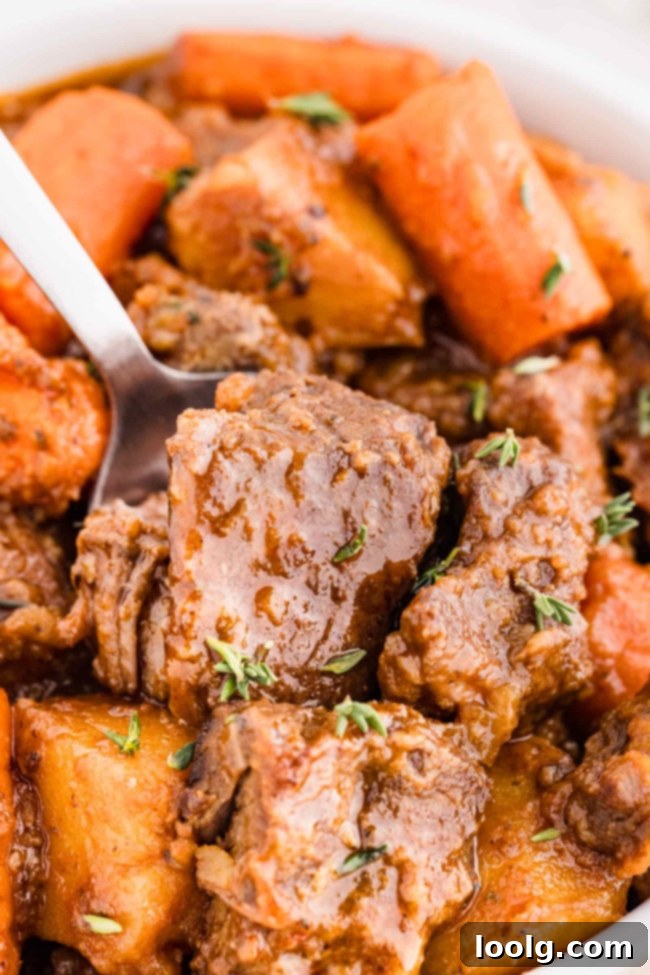
For those times when you need a quicker venison meal, consider preparing this flavorful Venison Tenderloin or a succulent Venison Backstrap, which can be cooked much faster while still delivering incredible taste.
What You’ll Love About This Venison Stew
- This venison stew boasts an incredibly rich, deeply savory, and hearty flavor profile, achieved through the harmonious blend of tender venison, a colorful array of fresh vegetables, and a thoughtfully selected mix of aromatic herbs and spices. Every bite is packed with layers of robust taste.
- You’ll appreciate the simple ingredients and straightforward preparation process that makes this stew remarkably accessible for any home cook, regardless of their experience level. It’s an uncomplicated recipe that delivers complex flavors without the fuss.
- The recipe is wonderfully versatile and can be easily customized with your preferred vegetables or readily adapted to accommodate various dietary preferences. For instance, it’s naturally dairy-free, and with a few simple tweaks, it can also be made completely gluten-free without sacrificing taste or texture.
Essential Ingredient Notes for Your Deer Meat Stew
Crafting a truly exceptional venison stew begins with understanding your ingredients. Below, you’ll find detailed notes for the main components of this recipe. For the complete list and precise measurements, please refer to the comprehensive recipe card located further down the page.
- Venison: The star of our show. When possible, opt for cuts like venison chuck or shoulder. These tougher, working cuts are ideal for slow-cooking because their connective tissues break down over time, yielding incredibly tender, fall-apart meat that absorbs all the rich flavors of the stew. If venison is unavailable, quality beef chuck or shoulder can be substituted with excellent results.
- Flour: Used to lightly coat the venison, the flour serves two crucial purposes: it aids in browning the meat beautifully, creating a flavorful crust, and it acts as a thickening agent for the stew. For those with dietary restrictions, a good quality gluten-free all-purpose flour blend or even cassava flour works perfectly. If you’re exploring low-carb options, consider recipes like this Keto Beef Stew, which omits flour.
- Olive Oil: Essential for searing the venison and sautéing your vegetables, olive oil provides a subtle fruity undertone. You can easily substitute it with other neutral cooking oils like canola, vegetable, or avocado oil, depending on your preference.
- Red Wine: A secret weapon for adding a magnificent layer of richness and depth to the stew. The alcohol cooks off, leaving behind complex flavors that enhance the venison beautifully. If you prefer not to use wine, a robust beef broth or even water can be used as a direct substitute, though it might result in a slightly less complex flavor profile.
- Yukon Gold Potatoes: These golden-fleshed potatoes are a fantastic choice for stew because they are waxy enough to hold their shape well during long cooking times, yet become wonderfully tender. Other waxy varieties like red potatoes are also great alternatives and can be used for dishes like these delicious Red-skinned Mashed Potatoes.
- Beef Broth: This forms the savory base of our stew, infusing it with umami and rich beefy flavor. For variations, chicken broth or vegetable broth can be used, keeping in mind they will alter the overall taste slightly. Ensure your broth is dairy-free if following a dairy-free diet.
- Worcestershire Sauce: A powerhouse of umami, Worcestershire sauce adds a deep, savory, and slightly tangy note that complements the venison perfectly. If you don’t have it, a dash of soy sauce (or tamari for gluten-free) can offer a similar savory depth.
- Bay Leaf: A single bay leaf imparts a subtle, earthy, and slightly floral aroma to the stew. Remember to remove it before serving, as it’s not meant for consumption.
- Cornstarch: This is an optional thickening agent, perfect for achieving your desired stew consistency. A slurry made with cornstarch and cold water can be stirred in at the end if you prefer a thicker gravy.
- Herbes de Provence: This classic French herb blend typically includes dried savory, marjoram, rosemary, thyme, and oregano, often with lavender. It imparts a fragrant, aromatic complexity to the stew. If you don’t have Herbes de Provence, you can create a similar blend using 1/2 teaspoon dried thyme, 1/2 teaspoon dried rosemary (crushed for better texture), 1/4 teaspoon dried oregano, and 1/4 teaspoon dried basil. For an even more authentic touch, a small pinch of dried marjoram or savory can be added if you have them on hand, but don’t feel the need to buy them specifically for this recipe. However, it’s certainly worth it if you plan to make a homemade batch of Herbes de Provence regularly!
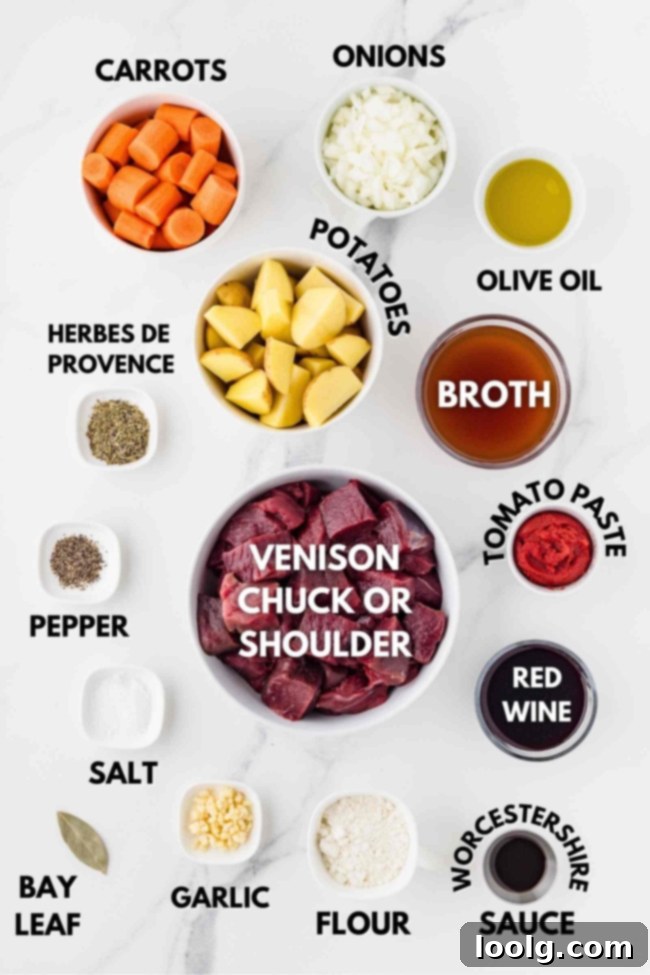
Choosing the Best Venison Cut for a Flavorful Stew
Selecting the right cut of meat is absolutely crucial when aiming for a tender and deeply flavorful venison stew. For this recipe, venison chuck or shoulder are highly recommended as they are perfectly suited for the low-and-slow cooking method that defines a great stew. These cuts contain a good amount of connective tissue, which, while initially tough, transforms into gelatin during prolonged simmering. This process not only tenderizes the meat to a melt-in-your-mouth consistency but also enriches the stew’s broth with a silky, luxurious texture and enhanced flavor.
Beyond chuck and shoulder, other excellent cuts for stewing include the neck, shank, and brisket. These also benefit immensely from long, moist-heat cooking, becoming incredibly tender and flavorful. Should venison not be readily available, a high-quality beef chuck or shoulder will serve as an excellent substitute, requiring no modifications to the recipe instructions and still delivering a wonderfully satisfying stew.
Does Venison Become More Tender with Longer Cooking?
The tenderness of venison as it cooks is highly dependent on the cooking method and the specific cut of meat used. Generally, venison, being a very lean meat with minimal fat, can easily become tough if cooked too long at high temperatures. The muscle fibers can seize up, resulting in dry, chewy meat.
However, when using slow, low-temperature cooking methods, such as braising or stewing – like in this recipe – the outcome is quite different. For tougher cuts like the shoulder, chuck, or shank, the prolonged, gentle heat effectively breaks down the collagen and other connective tissues. Over several hours, these tissues dissolve into gelatin, which tenderizes the meat dramatically, making it succulent and easy to pull apart with a fork.
Conversely, for naturally tender cuts such as venison backstrap or tenderloin, quick, high-heat cooking (like searing or grilling) is the preferred method to prevent them from drying out. Overcooking these lean, tender cuts will indeed make them tough, as there isn’t enough connective tissue to break down and re-moisturize the meat.
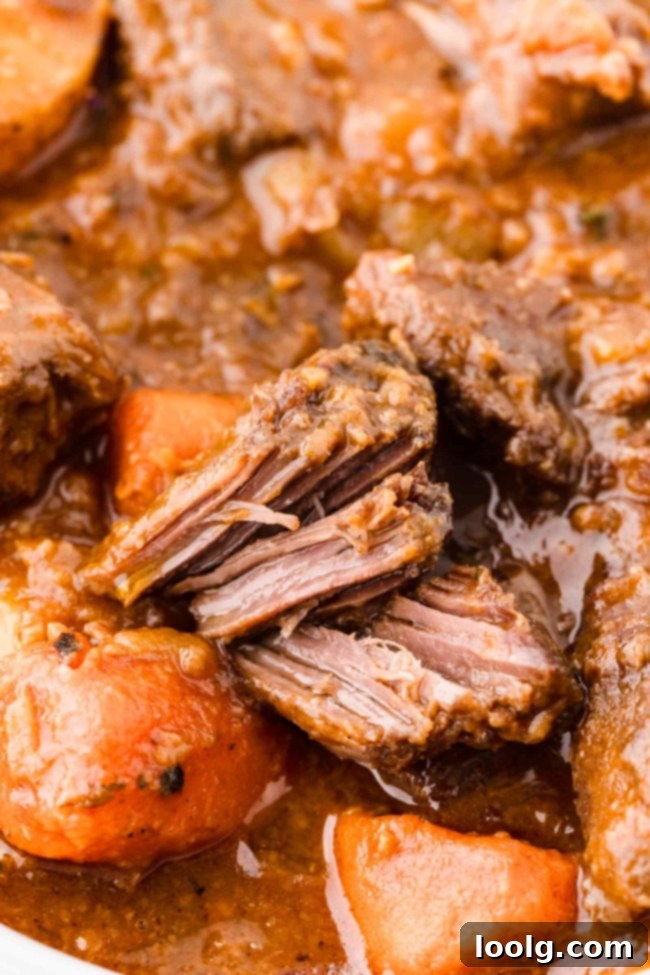
Expert Tips for Reducing Gamey Flavor in Venison Stew
While many appreciate the distinctive flavor of venison, some individuals find it to be too “gamey.” If you’re looking to mellow out this characteristic taste in your venison stew, here are a few highly effective tips:
- Soak the Meat: A classic and highly effective method is to soak the venison in milk or buttermilk for several hours, or even overnight, before cooking. The lactic acid in milk helps to draw out some of the stronger flavors and tenderize the meat, resulting in a milder taste. While I didn’t find this step necessary for my personal preference in this recipe, it’s an excellent option if you’re serving individuals (especially picky eaters or children) who are sensitive to gamey flavors.
- Utilize Bold Flavors: Incorporating robust and aromatic ingredients is key to balancing venison’s natural intensity. Ingredients like plenty of garlic and onions, a good splash of red wine, a savory hit of Worcestershire sauce, and a generous medley of herbs (like the Herbes de Provence in this recipe) work synergistically. These powerful flavors complement the venison, transforming any gamey notes into a delightful earthiness.
- Trim Excess Fat Thoroughly: Venison fat tends to carry the most concentrated “gamey” flavor. Before cooking, meticulously trim off any visible fat, sinew, or silver skin from the meat. This simple step can significantly reduce the gamey taste in your final dish and contribute to a cleaner flavor.
- Cook Low and Slow: As emphasized throughout this recipe, slow-cooking is paramount for venison stew. This method not only tenderizes tougher cuts by breaking down connective tissues but also allows all the ingredients to meld and harmonize over an extended period. The gradual cooking process helps to mellow the venison’s flavor, creating a more cohesive and less pronounced gamey taste in the finished stew.
Crafting Your Delicious Venison Stew: A Step-by-Step Guide
Making this venison stew follows a process similar to many other stovetop stew recipes, but with a crucial difference: we take a few extra, intentional steps to build layers of incredible flavor. Unlike simply dumping everything into a slow cooker, this method ensures maximum deliciousness and a rich, complex broth.
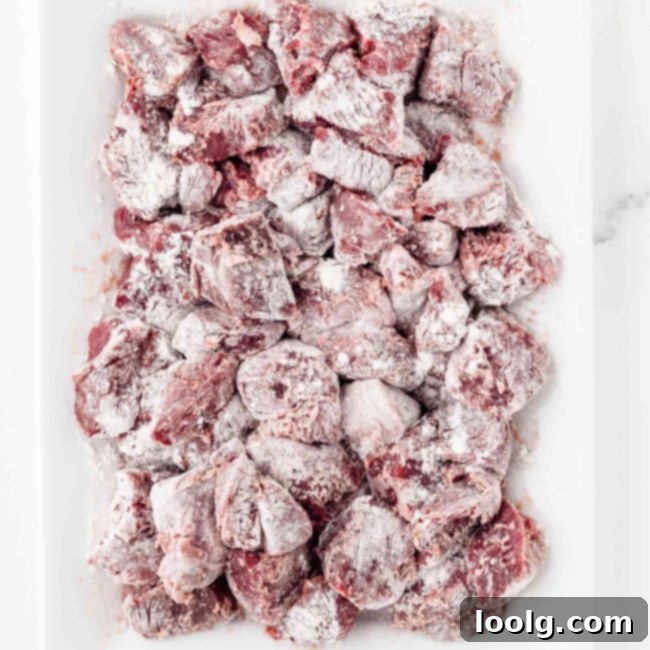
Step 1: Prepare and Season the Venison. Begin by cutting the venison into uniform bite-sized pieces, about 1.5 inches (4 cm). Ensure you trim away any large pieces of fat or tough sinew. Season the meat generously with salt and black pepper, then sprinkle with flour and toss to coat evenly. This coating aids in browning and helps to thicken the stew later.
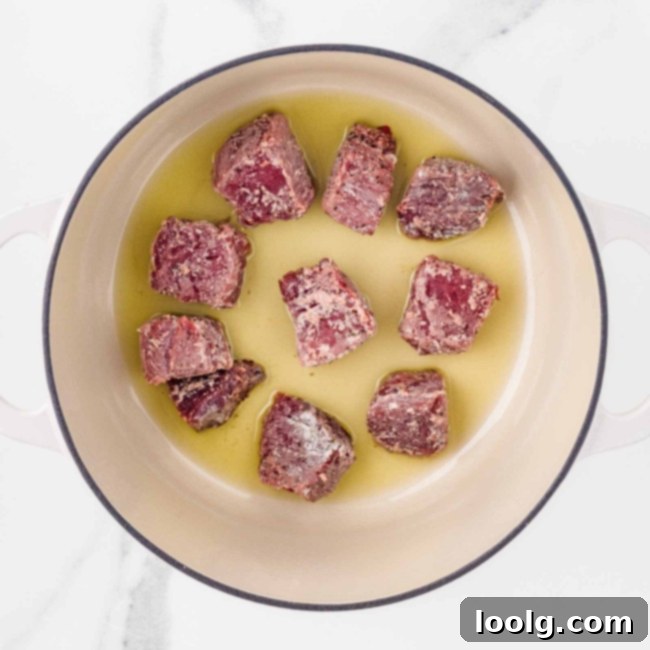
Step 2: Load the Dutch Oven. Add the flour-coated venison pieces to a preheated Dutch oven with olive oil. It’s crucial not to overcrowd the pot; work in batches if necessary to ensure proper browning rather than steaming.
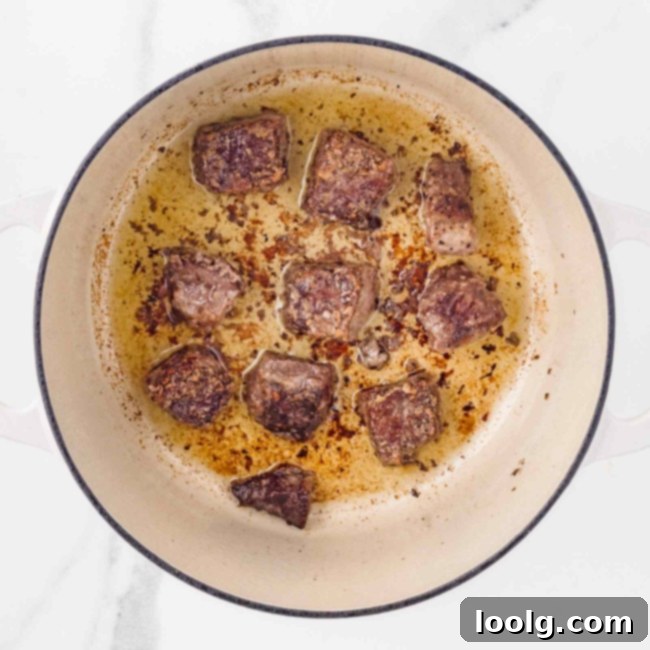
Step 3: Brown the Venison. Sear the venison on all sides in the hot Dutch oven with olive oil. This step is vital for developing a rich, caramelized crust that contributes immense flavor to the stew. Aim for about 3-4 minutes per batch until beautifully browned.
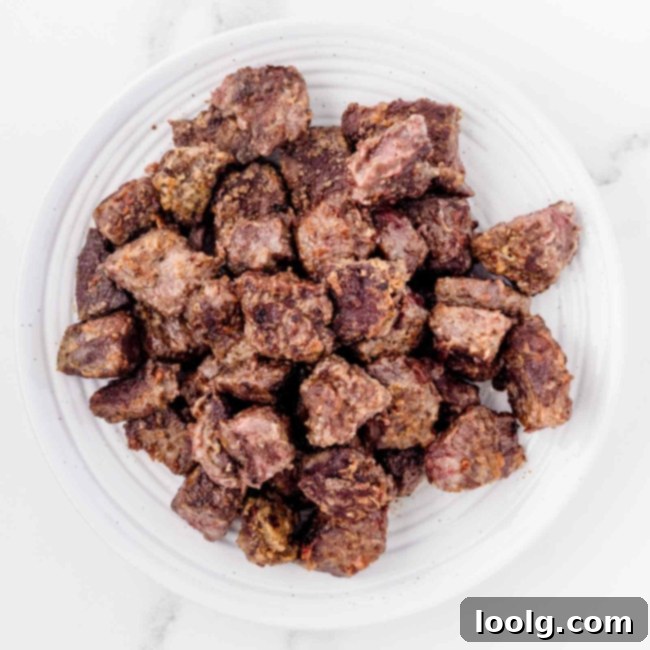
Step 4: Set Aside Browned Meat. Once each batch of venison is nicely browned, remove it from the Dutch oven and transfer it to a plate. You’ll likely need to repeat this process a few times, adding more olive oil as needed, to avoid overcrowding the pan.
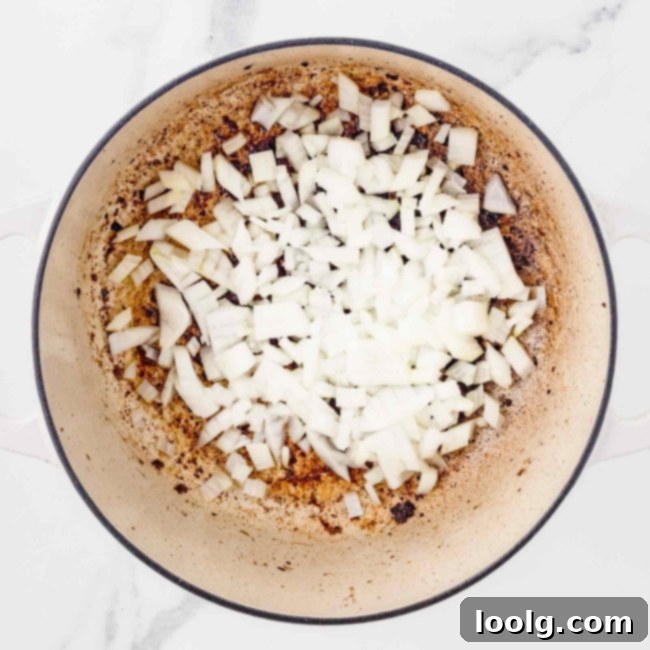
Step 5: Sauté the Onions. In the same pot, add the chopped yellow onion. Cook, stirring occasionally, until the onion softens and turns lightly browned around the edges, which should take approximately 4-6 minutes. These browned bits will add extra flavor.
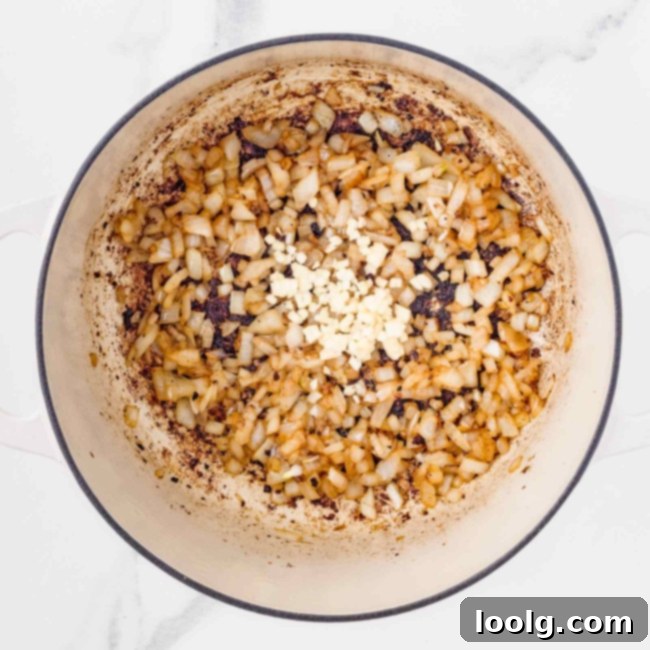
Step 6: Incorporate the Garlic. Add the minced garlic to the softened onions and cook for just one more minute, stirring constantly. Be careful not to burn the garlic, as this can make it bitter.
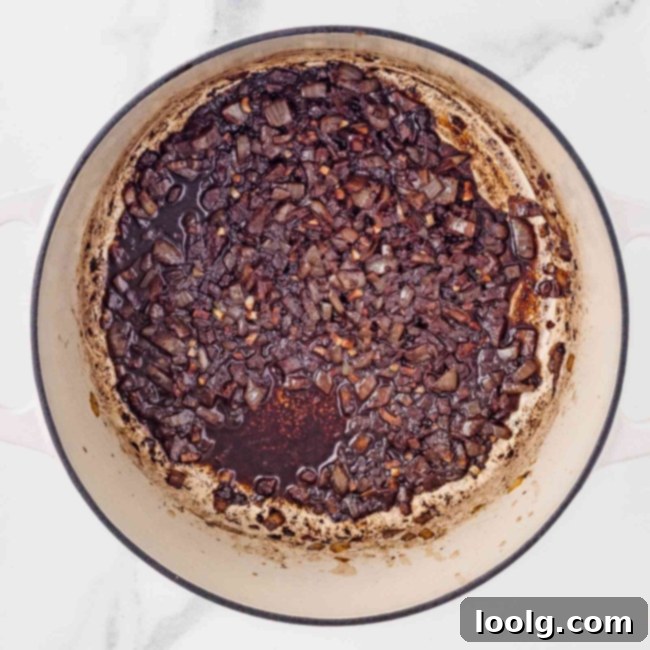
Step 7: Deglaze with Wine. Pour the red wine into the Dutch oven. Use a wooden spoon or spatula to scrape up all the flavorful browned bits (fond) stuck to the bottom of the pot. This deglazing step is crucial for incorporating deep flavor. Cook until most of the liquid has evaporated, leaving behind concentrated flavor.
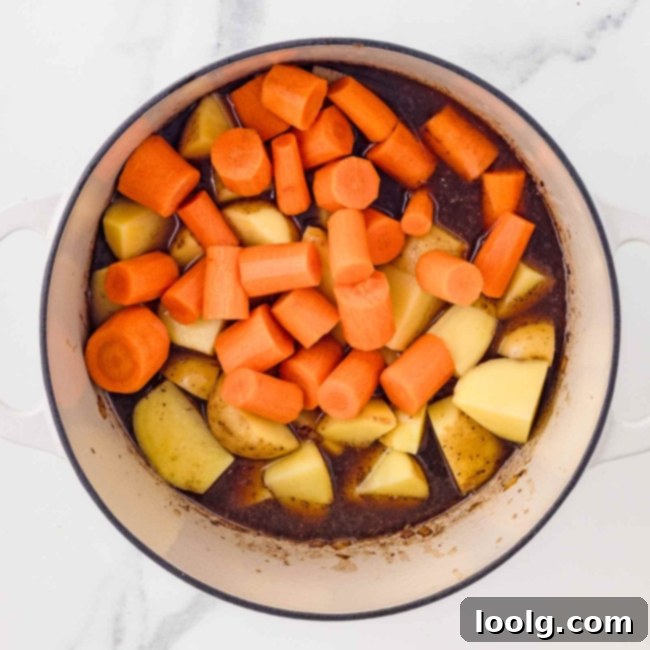
Step 8: Add Vegetables and Broth. Introduce the chopped potatoes and carrots to the pot, then pour in the beef broth. This liquid will be the savory base of your stew.
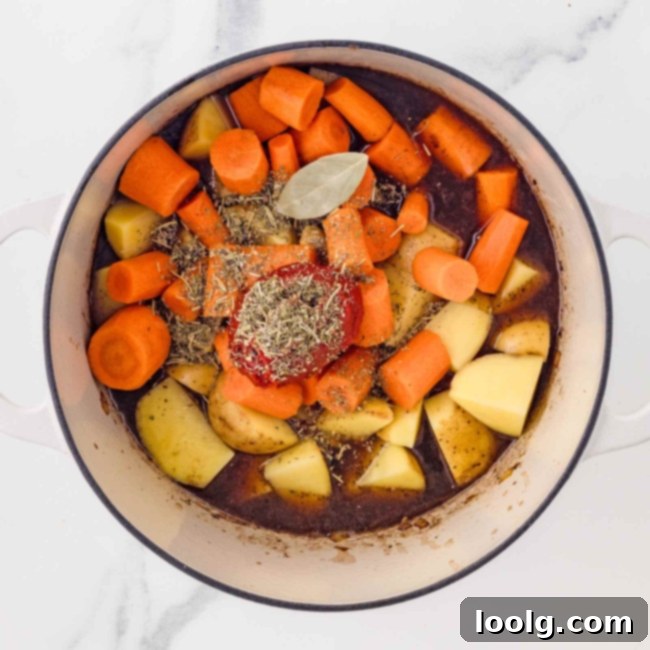
Step 9: Season with Flavor Boosters. Stir in the tomato paste for a touch of sweetness and acidity, Worcestershire sauce for umami, Herbes de Provence for aromatic complexity, and the bay leaf. Mix until everything is well combined.
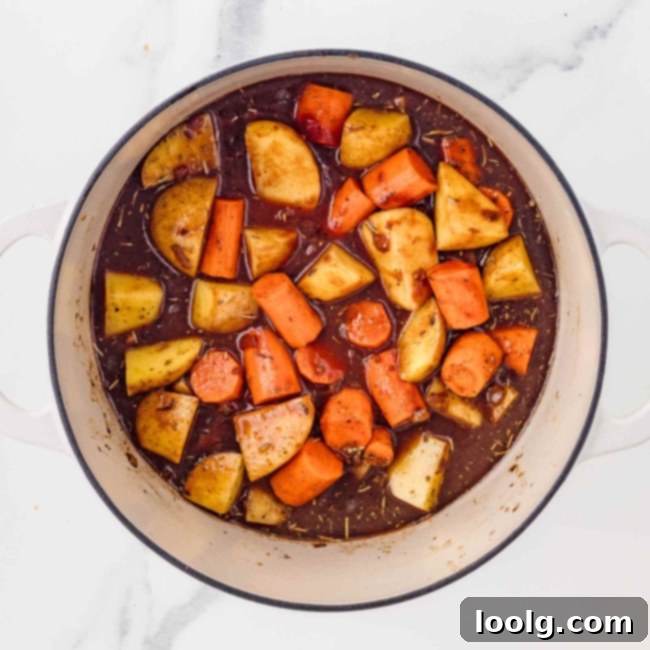
Step 10: Initiate Simmering. Bring the entire mixture to a gentle simmer, stirring occasionally to ensure all ingredients are evenly distributed and heated through.
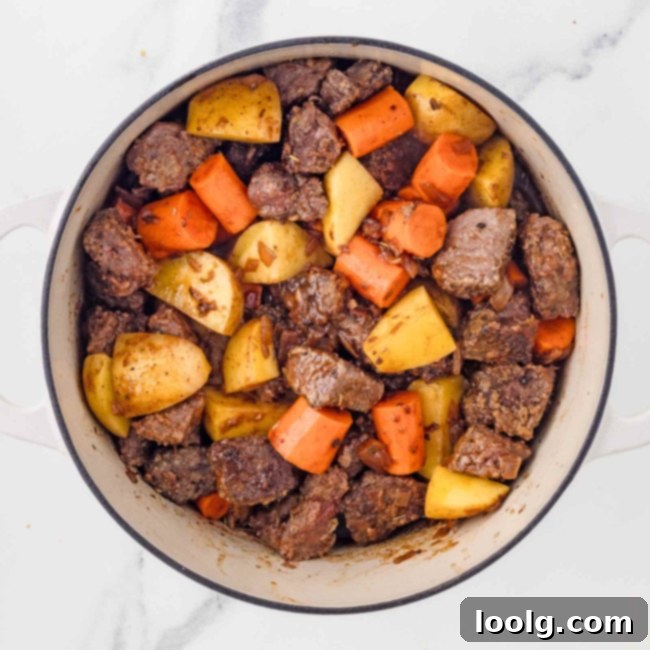
Step 11: Return Venison and Cover. Once the mixture is simmering, return the previously browned venison, along with any delicious accumulated juices from the plate, to the pot. Stir everything together gently, then reduce the heat to low and cover the Dutch oven with its lid.
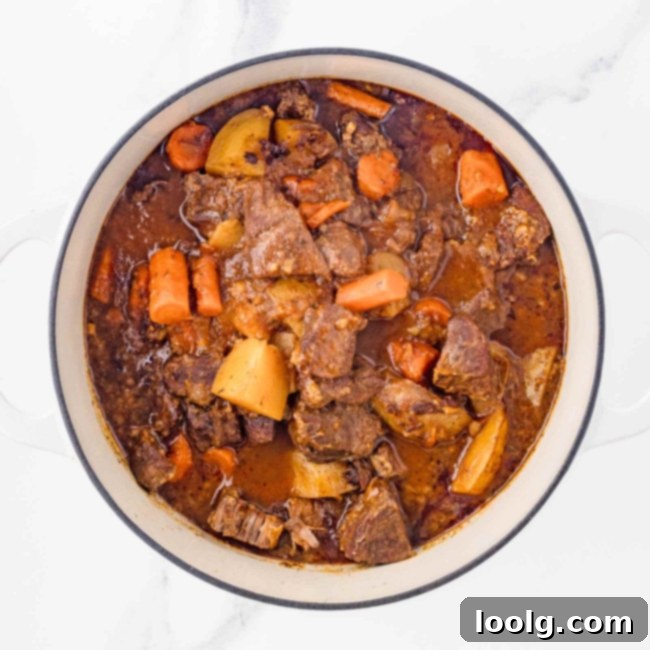
Step 12: Slow Simmer to Perfection. Allow the stew to simmer very gently for approximately 2 to 2 1/2 hours. This extended, low-heat cooking is crucial for the venison to become exceptionally tender and easily pierced with a fork. Stir occasionally to prevent any sticking to the bottom and to ensure even cooking and distribution of flavors.
Expert Cooking Tips for the Best Venison Stew
- Always Brown the Meat First: This step is non-negotiable for a truly flavorful stew, even if it feels like an extra effort. Searing the venison creates a rich, caramelized crust through the Maillard reaction, which adds incredible depth and savory notes that cannot be achieved by simply simmering raw meat. Skipping this step means sacrificing a significant layer of flavor.
- Avoid Overcrowding the Pan During Searing: When browning your venison, resist the temptation to dump all the meat into the pot at once. Overcrowding lowers the pan’s temperature, causing the meat to steam rather than sear. This results in pale, grey meat that lacks the desired browned crust and, consequently, the deep flavor. Work in small batches, ensuring each piece has enough space to make contact with the hot pan, allowing for proper caramelization.
- Utilize a Heavy-Bottomed Pot (Preferably a Cast Iron Dutch Oven): A heavy-bottomed pot, especially a cast iron Dutch oven, is ideal for stewing. Its excellent heat retention and even heat distribution prevent hot spots that can lead to scorching the bottom of your stew. This consistent, gentle heat is crucial for slowly breaking down tough cuts of venison and ensuring they become uniformly tender without drying out or burning.
- Maintain a Gentle Simmer: Venison is inherently very lean, meaning it lacks the internal fat that helps keep other meats moist and tender during cooking. High heat can cause the muscle fibers to contract too quickly, making the meat tough and dry. Furthermore, the connective tissues (collagen) in tougher cuts require slow, gentle heat to gradually break down into gelatin. If the heat is too high, the collagen can seize up instead of dissolving properly, resulting in chewy, unpleasant meat. A gentle simmer is key to achieving that desirable, fall-apart texture.
Simple Slow Cooker Directions for Venison Stew
For those days when you need the convenience of a slow cooker, this venison stew recipe can be easily adapted. While the stovetop method allows for more intense flavor building, these steps ensure a delicious and tender stew with minimal hands-on time.
- Sear the Meat: Begin by heating a pan over medium-high heat and adding a bit of oil. Sear the venison pieces until they are nicely browned on all sides. This browning step is essential for adding a foundational depth of flavor to your stew, which is harder to achieve directly in a slow cooker. You will likely need to work in a few batches to prevent overcrowding the pan. Transfer the browned meat directly into your slow cooker.
- Sauté Aromatics and Deglaze: In the same pan you used for the venison, add the chopped onions, carrots, and minced garlic. Sauté them until they are softened and fragrant, scraping up any browned bits from the bottom of the pan as you go. Next, pour in the red wine to deglaze the pan thoroughly, ensuring all those flavorful remnants are incorporated. Transfer this aromatic mixture into the slow cooker with the venison. Add all remaining stew ingredients into the slow cooker.
- Slow Cook to Perfection: Cover your slow cooker and cook the stew on the low setting for approximately 7-9 hours. This extended, gentle cooking period will allow the venison to become exceptionally tender and for all the flavors to meld beautifully, creating a rich and satisfying meal.
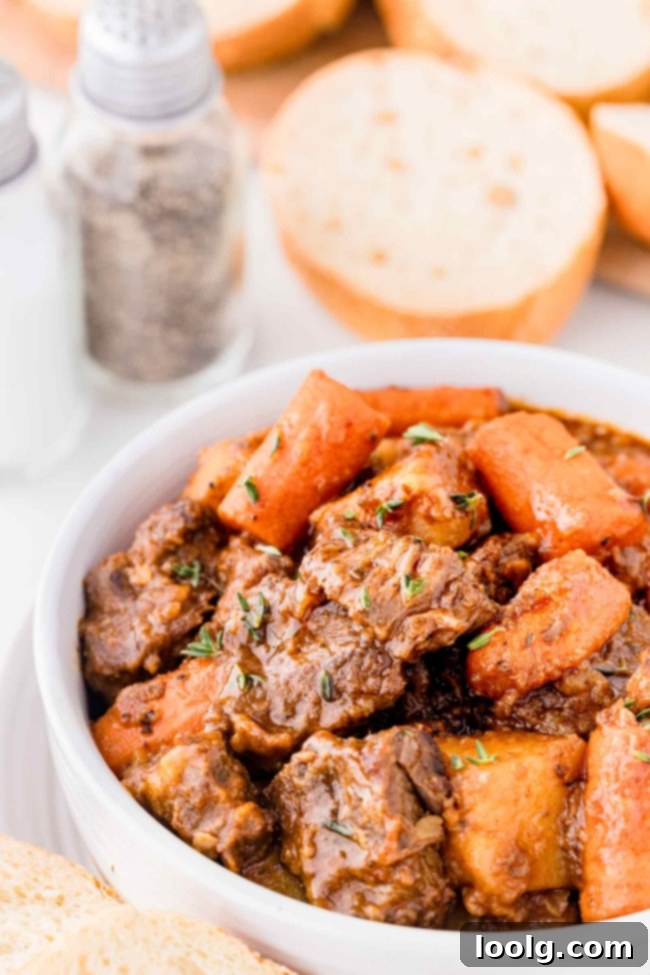
How to Store and Reheat Your Venison Stew
Proper storage and reheating are key to enjoying your venison stew even days after it’s made. This hearty dish often tastes even better the next day as the flavors continue to meld and deepen.
- Refrigerate: Always allow the stew to cool completely at room temperature (no longer than 2 hours) before transferring it to an airtight container. Stored in the refrigerator, it will maintain its quality and flavor for up to 3 days.
- Freeze: For longer-term storage, cool the stew completely, then transfer it to freezer-safe containers or heavy-duty freezer bags. Ensure there’s minimal air inside to prevent freezer burn. It can be safely frozen for up to 3 months. When you’re ready to enjoy it, thaw the frozen stew in the refrigerator overnight before reheating.
- Reheat: The best way to reheat venison stew is gently on the stovetop. Transfer the desired portion to a saucepan and reheat over medium heat, stirring occasionally, until it is heated through. If the stew has thickened too much in the fridge, you can add a splash of broth or water to achieve your preferred consistency. Avoid microwaving large portions, as it can sometimes lead to uneven heating.
Delicious Ways to Serve Your Hearty Deer Stew
This venison stew is a complete meal on its own, but it truly shines when paired with certain accompaniments. Here are some fantastic serving suggestions to enhance your dining experience:
- Crusty Bread: A classic and always satisfying choice! Serve the stew with generous slices of warm, crusty bread to soak up every last drop of the rich, flavorful broth. This Overnight Sourdough Bread is a particularly delicious option that complements the rustic nature of the stew perfectly.
- Creamy Mashed Potatoes: If you’ve chosen to omit potatoes from the stew itself, mashed potatoes are an indispensable side. Their creamy texture and mild flavor provide a perfect counterpoint to the stew’s robustness. While these Cheesy Mashed Potatoes offer an indulgent experience, these lighter yet still wonderfully rich Yukon Gold Mashed Potatoes are also an excellent pairing.
- Fresh Green Salad: To balance the richness of the stew, a light and refreshing side salad with a tangy vinaigrette can be a wonderful addition. It provides a crisp texture and a welcome contrast in flavors.
- Steamed Green Vegetables: Boost the nutritional value and add a vibrant touch with a side of simply steamed vegetables. Options like crisp green beans, tender broccoli florets, or sweet peas are all excellent choices that cook quickly and beautifully complement the stew.
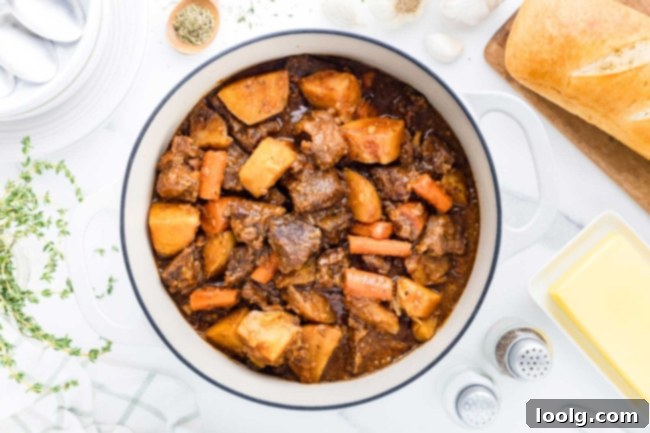
Making Your Venison Stew Gluten-Free and Dairy-Free
This venison stew recipe is remarkably adaptable, making it simple to prepare a delicious version that caters to both gluten-free and dairy-free dietary needs without compromising on flavor or texture.
For a Gluten-Free Stew:
- Flour Substitution: The primary ingredient to consider is the flour used to coat the venison and thicken the stew. Instead of all-purpose wheat flour, opt for a reliable 1-to-1 gluten-free all-purpose flour blend. Many excellent blends are available that work beautifully in stews. I’ve personally had great success using both cassava flour and oat flour in this specific venison stew recipe, yielding wonderful results in terms of browning and thickening.
- Worcestershire Sauce: While most traditional Worcestershire sauces contain naturally gluten-free ingredients, some brands may use malt vinegar, which is derived from barley and therefore not gluten-free. It’s crucial to check labels carefully. In the US, Lea & Perrins – The Original Worcestershire Sauce is specifically labeled as gluten-free. However, be aware that the formulation in Europe and Canada often contains malt vinegar, making it unsuitable for a gluten-free diet there. French’s and The Wizard’s Gluten-Free Vegan Worcestershire Sauce are also widely available and certified gluten-free options.
- Broth: Always double-check the label on your beef broth. While most broths are naturally gluten-free, some cheaper or highly processed brands might contain gluten-containing additives or thickeners.
For a Dairy-Free Stew:
- This recipe is naturally dairy-free with careful selection of ingredients.
- Beef Broth: The main component to verify is your beef broth. The vast majority of beef broths are dairy-free, but always take a moment to read the ingredient list to ensure no unexpected dairy products have been added.
- Worcestershire Sauce: As mentioned above, most Worcestershire sauces are dairy-free. Again, a quick check of the label will confirm this for your chosen brand.
By keeping these simple substitutions and label checks in mind, you can effortlessly create a hearty, comforting venison stew that everyone can enjoy, regardless of their dietary restrictions.
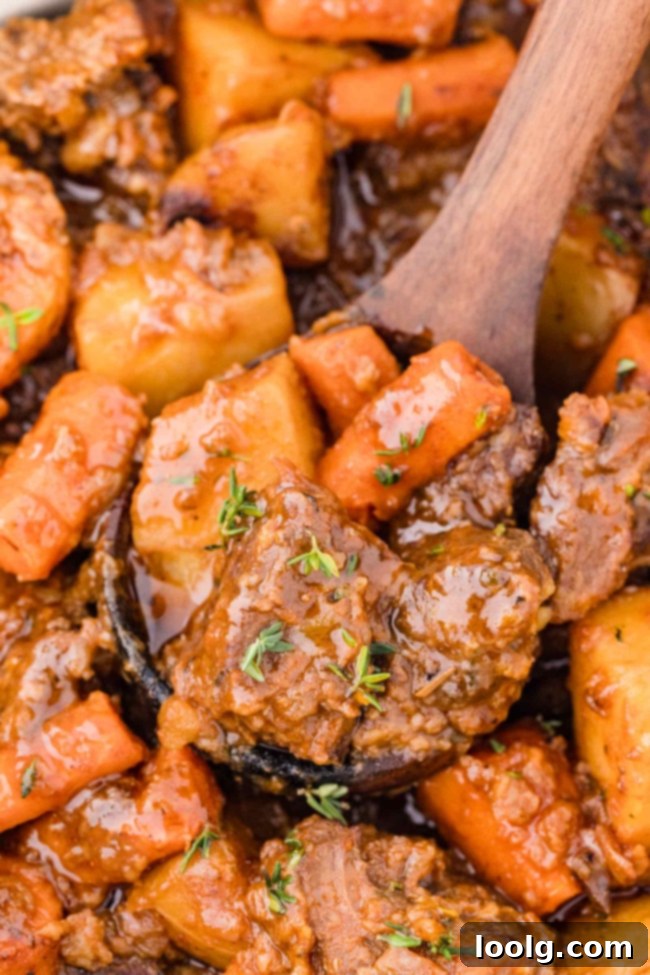
✨🍪Did you create this delicious venison stew?🍪✨
We’d love to hear your thoughts! Please share your experience by leaving a ✍️review and 🌟 rating below – your feedback is invaluable to me and helps other cooks! I truly appreciate it. 💖
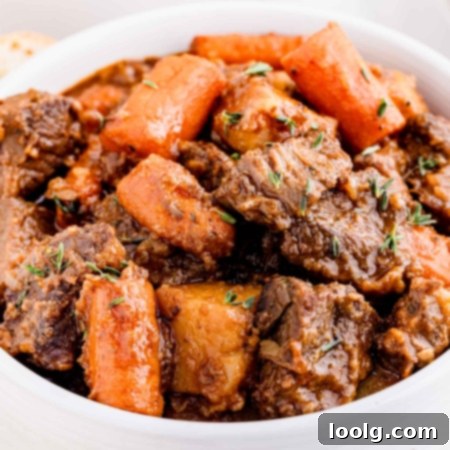
Venison Stew Recipe
Ingredients
- 2 pounds (900 grams) venison chuck or shoulder
- 1 teaspoon salt
- 1/2 teaspoon coarsely ground black pepper
- 3 tablespoons all-purpose flour see notes for gluten-free
- 3-4 tablespoons olive oil
- 1/2 (100 grams) large yellow onion chopped
- 5 garlic cloves minced
- 1/2 cup (120 ml) red wine
- 1 pound (453 grams) Yukon Gold potatoes cut into 1″ (2.5 cm) pieces
- 3 large carrots cut into 1″ (2.5 cm) pieces
- 1 1/2 cups (355 ml) beef broth
- 1/4 cup tomato paste
- 1 tablespoon Worcestershire sauce
- 1 1/2 teaspoons Herbes de Provence
- 1 bay leaf
- 1 tablespoons cornstarch, optional
Instructions
-
Cut the venison into bite-sized pieces, about 1.5” (4 cm), making sure to remove any larger amounts of fat and any sinew tissue.
-
Season the venison pieces all over with salt and coarsely ground black pepper. Sprinkle the flour over the seasoned venison and toss to coat evenly.
-
Heat 2 tablespoons of olive oil in a large Dutch oven over medium heat. When the oil is hot and shimmering, add the venison in batches. Brown the venison on all sides, about 3-4 minutes per batch, until it develops a rich, brown crust. Do not overcrowd the pot! Transfer the browned venison to a plate and set aside. Add more oil as needed for subsequent batches.
-
In the same Dutch oven, add the chopped yellow onion. Cook, stirring occasionally, until the onion is softened and lightly browned around the edges, about 4-6 minutes. Add the garlic and cook for one more minute, stirring frequently.
-
Pour the wine into the Dutch oven. Use a wooden spoon/spatula to scrape up any browned bits from the bottom of the pot to deglaze it. Continue cooking until the liquid has mostly evaporated.
-
Add the chopped potatoes and carrots to the pot and pour in the beef broth. Stir in the tomato paste, Worcestershire sauce, Herbes de Provence and the bay leaf.
-
Bring the mixture to a simmer, stirring occasionally to combine all the ingredients. Once the mixture is simmering, return the browned venison, along with any accumulated juices, to the pot. Stir to combine.
-
Reduce the heat to low and cover the pot with the lid.
-
Let the stew simmer gently (don’t rush it!) for about 2 to 2 1/2 hours or until the venison is very tender and easily pierced with a fork. Stir occasionally to prevent sticking and ensure even cooking.
-
Remove the bay leaf from the stew. Taste and season with additional salt and pepper, if necessary.
-
If you need to thicken it – in a small bowl, mix 1 tablespoon of cornstarch with 2 tablespoons of cold water until smooth.
-
Gradually stir the slurry into the simmering stew. Allow it to cook for 1 minute to thicken, stirring occasionally. Repeat if necessary until you reach the desired consistency.
-
Allow the stew to cool completely before transferring to an airtight container. Store in the refrigerator for up to 3 days or freeze for up to 3 months.
Notes
- If you’re serving it as a main dish with bread or sides, it could stretch to 6 servings. If serving larger bowls, expect about 4 servings.
- If gluten-free, use a 1-to-1 gluten-free flour blend, cassava flour or oat flour. I’ve tried all 3 in this recipe with great results! Also, make sure your Worcestershire and broth are gluten-free. The same is true if you’re dairy-free.
